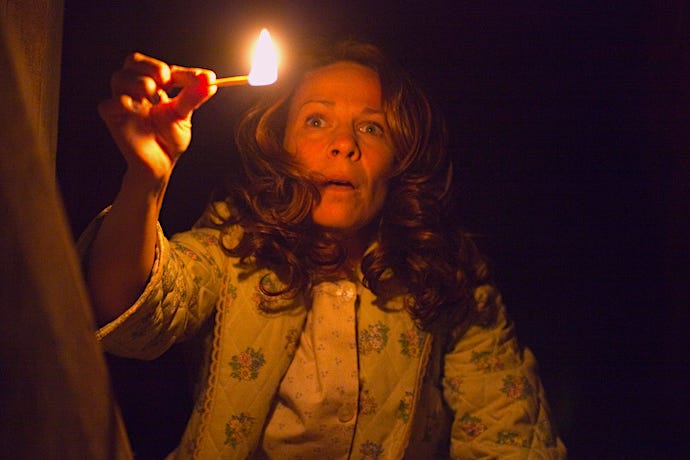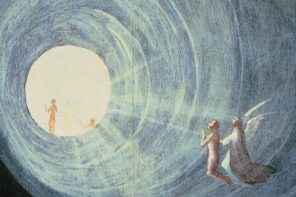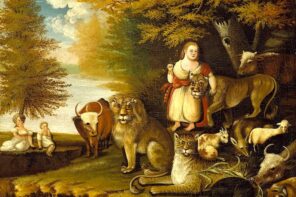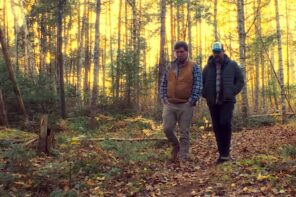While researching ghost hunters in the 21st century US during the course of earning my PhD, I was sometimes asked what ghost-hunting had to do with religious studies. In fact, Americans’ interactions with ghosts often reveal their personal spiritualities and religious worldviews—especially when those worldviews don’t fit neatly into traditional religious boxes.
A haunting is like a canvas on which people paint their religious worldviews using the unique tools their culture provides them. I’m not the first to suggest a culture’s hauntings reflect its religious milieu. Psychologist Frank T. McAndrew has argued that, for example, medieval European Christian, or contemporary Muslim or Hindu or Buddhist, afterlife and spirit beliefs affect how these societies portray and interpret hauntings.
I’m as interested as anyone in whether or not ghosts exist, but that isn’t my concern here; what I’m interested in is the way that a haunting can shine a light on the American spiritual landscape in ways that surveys or investigations cannot. Which is what led me to Maria.
Maria began to suspect the property she was renting in Lancaster, Pennsylvania was haunted after about a month. Weird things kept happening. At Maria’s home, the cabinets were often found open in the kitchen. At first she suspected the cats. Then, at some point Maria and her husband installed a video camera to monitor the room overnight. One morning, they walked out into the kitchen to find all the cabinets wide open—even the upper cabinets that were well out of reach of the cats. The door leading to the garage was also wide open letting the cats out into the garage. When they checked the footage they found that the camera had stopped transmitting at around 1 A.M.
Soon after, Maria’s husband began experiencing the strong smell of cigarette smoke near him in the house at seemingly random times. He would also see black shadows racing across the floor when there was no one around and nothing to cast them. The couple’s nanny, before the couple had ever mentioned the idea of a haunting, saw a bright orb of light in the baby’s room. Maria saw a disturbing amorphous black mass hovering in the corner of the couple’s bedroom. Sometimes Maria, her husband, and one of their daughters would experience intense nightmares during the same night.
In my experience researching ghost hunters, I’ve found that a haunting often begins with one or more anomalous experiences—strange phenomena that evade standard explanations. What’s important is that these experiences demand explanation, and that people draw on their cultural lenses to explain them. Maria believed in ghosts and hauntings before her experiences in the Lancaster house.
Growing up in a Latina household in south Texas, Maria was told ghost stories like those of the legendary La Llorona, the ghostly weeping woman, and she enjoys what she describes as “Catholic horror movies,” such as The Conjuring in which Catholic heroes fight off demons.
Maria drew from these word-of-mouth tales and the media she consumes to conclude that these otherwise unexplainable phenomena were a haunting caused by ghosts. Maria isn’t particularly odd or deviant; survey data show that paranormal belief is common for Americans of all demographics.
Maria’s husband Mark, who describes himself as religiously agnostic, didn’t believe in ghosts before his experience of the Lancaster house. At first he rejected Maria’s talk and, when forced, preferred to talk about some sort of “energy” being in the house. Mark’s instinct is a common one in the United States. Like many ghost hunters, he sought to scientize his seemingly paranormal experiences. To people like Mark, the idea of a ghost seems unbelievable or superstitious. Something was going on, he believed, but calling it “energy” was more comfortable as it seemed more in line with our scientific understanding of the world.
Maria’s response to the haunting is in keeping with a type of spirituality she shares with an increasing number of Americans. She holds what some academics would call a form of metaphysical spirituality. Historian of American religion Catherine Albanese traces metaphysical religion or spirituality through New Age spirituality back through late-nineteenth and early-twentieth century Theosophy and back to Spiritualism and Mesmerism. It’s a type of spirituality concerned with intuition, the therapeutic, and the flow of spiritual energy. More and more Americans are embracing metaphysical forms of spirituality as they move away from traditional religious affiliation.
Maria originally responded to the haunting by attempting a house-cleansing derived from her training in Reiki. She lit candles, used hand motions to direct energy, and imagined the house filling with pure, cleansing light. She also consulted a friend who practices New Age spirituality, such as Akashic record readings, who reported sensing a strange energy in the house.
She reported that, whenever she tried to speak to this friend on the phone in the house about the haunting, the phone connection would be interrupted. As a busy woman with two kids, Maria doesn’t always have a lot of time to devote to spirituality, but when she does, she often relies on intuition. In the case of the haunting, she reports that her intuition pointed her toward the conclusion that it’s the land on which the house was built that’s haunted, rather than the house itself.
This particular haunting account reveals the eclectic spirituality of a single American couple, but it isn’t theirs alone. They’ve drawn from community narratives, popular media, popular understandings of science, and widely circulating currents of metaphysical spirituality to build this portrait of a haunting. They’ve interpreted a set of anomalous experiences through their cultural lenses. My research suggests this haunting is typical in the US, and I would suggest that by studying American hauntings, we can better understand the American spiritual landscape.
###
UPDATE 1/24/22: Readers have been asking, with varying degrees of urgency, whether there are any updates or resolution to this story. The author, Daniel Wise, writes: “Maria and Mark moved out of the Lancaster house in December of 2021 for reasons unrelated to the haunting. A couple days before they left, Mark felt Maria get into bed—but when he checked there was nobody there in the bed beside him. Maria tells me they are happy to have moved on.”





